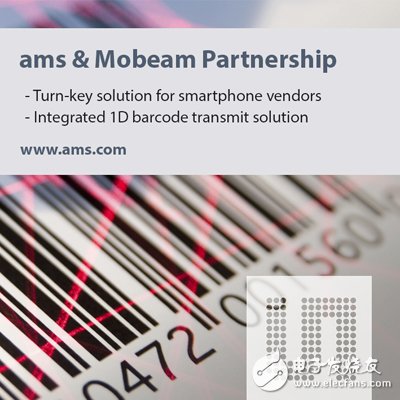Austrian Microelectronics and Mobeam bring a complete single-dimensional barcode transmission solution to smartphone manufacturers, ending the retailer ’s nightmare handling of paper coupons
China, February 26, 2013- Austrian Microelectronics (SIX stock code: AMS) and Mobeam today announced a strategic partnership, the two parties will work together to accelerate the performance of smart phone barcode content transmission to make Terminal (POS) laser scanners can read barcodes in smart phones. This strategic cooperation will bring complete solutions, including Austrian microelectronics industry-leading optical sensors and Mobeam's light-based transmission technology. Thanks to this collaboration, mobile phone manufacturers will be able to fully support mobile business applications that use barcodes, such as coupons, VIP cards, gift cards and tickets. For retailers, this means manually sorting paper coupons and waiting for the end of months to get reimbursement. The solution will be demonstrated at the Austrian Microelectronics booth (6C40-Hall 6) at the Mobile World Congress in Barcelona this week.

The United States issues about 350 billion paper coupons annually, with a total value of more than 470 billion US dollars. Paper coupons consume 13 million trees each year, and 99% of the coupons are actually never used. Since the laser scanners in most stores cannot scan the barcodes displayed on mobile phones, the dream of paperless "mobile coupon redemption" has not been realized. The technical cooperation between Austrian Microelectronics and Mobeam has enabled mobile phone manufacturers to overcome the last technical obstacle to mobile coupon redemption.
The cooperation between Austrian Microelectronics and Mobeam has solved the problem of restricting the development of mobile coupon redemption, that is, ordinary POS barcode readers cannot read barcode data on mobile phone displays. This cooperation combines Mobeam's technology and Austrian Microelectronics' digital light sensor module to bring a full set of solutions and unique product differentiation to smartphone manufacturers without the need for additional components. The TMD3990 module of Austrian Microelectronics uses the same infrared LED as the proximity sensor used in today's smartphones to disable the touch screen. This simplified approach will enable mobile phone manufacturers to gain new opportunities embedded in all mobile coupon redemption and mobile commerce.
John Heugle, CEO of Austrian Microelectronics, said: "The combination of Mobeam technology and Austrian microelectronic sensors will provide smartphone manufacturers with a simple, accurate and powerful integrated solution to enter the increasingly prosperous mobile coupon exchange and mobile commerce market. Our customers want us to help them create value and bring differentiated products to the market they are in, and our cooperation is dedicated to this. "
This year, more than 500 million people around the world are expected to receive mobile coupons, a 30% increase from 2012. The effective transmission of barcode data is an inevitable requirement to expand the mobile coupon exchange market. Allowing consumers to use smartphones to redeem electronic coupons will bring environmentally friendly solutions, improve convenience, and help accelerate the development of mobile commerce.
Chris Sellers, CEO of Mobeam, said: "We are very pleased to work with Austrian Microelectronics to promote the entire industry towards true mobile commerce. This collaboration with Austrian Microelectronics will enable smartphones to integrate our cost-effective Mobeam technology Become more convenient. "
Austrian Microelectronics now provides TMD3990 samples. The TMD3990, which combines color light sensing, proximity detection and infrared LED barcode transmission functions, will be mass produced in the third quarter of 2013.
About Austrian Microelectronics
Austrian Microelectronics designs and manufactures high-performance analog semiconductors to provide customers with innovative solutions to help solve the most challenging problems. Austrian microelectronics products are mainly aimed at applications requiring high precision, wide dynamic range, high sensitivity, noise resistance or ultra-low power consumption. Austrian Microelectronics provides products including sensors, sensor interfaces, power management ICs and wireless ICs to customers in the consumer, industrial, medical, mobile communications and automotive markets.
Headquartered in Austria, Austrian Microelectronics has more than 1,300 employees worldwide and serves more than 7,800 customers worldwide. Since acquiring the optical sensor company TAOS in 2011, ams has become the new name of Austrian microelectronics. Austrian Microelectronics is listed on the Swiss Stock Exchange (ticker symbol-Swiss Stock Exchange: AMS). For more information, please visit.
About Mobeam
Mobeam, inc. Is changing mobile commerce with its unique and patented light-based communication technology. The company was recently selected by market research company Lead411 as the fastest growing technology company in San Francisco in 2012. By helping mobile phones overcome technical obstacles in interacting with laser scanners at checkout, Mobeam ’s technology enables universal access to retail locations, enabling coupons, VIP discounts, gift cards, tickets and other barcodes for retailers worldwide Circulation and use of data. Mobeam's technology brings new features to existing mobile phone designs without changing the retailer's POS infrastructure. Mobeam is headquartered in San Francisco, California. For more information, please visit.
Sand Casting is made of clay-bonded sand as a molding material. It is a process method with a long history. It is also the most widely used process method. In the development of various chemical bonding sand, the clay wet sand is still the most important molding material, and its application range is wide and the consumption is large, and it is not comparable to any other molding material. It is reported that in the steel castings of the United States, more than 80% of the clay-wet molding sand is used; in Japanese steel castings, more than 73% of the clay-wet molding sand is used.
Sand Casting,Sand Casting Tube,Sand Casting Process,Inron Sand Casting Pats
Dongguan Formal Precision Metal Parts Co,. Ltd , https://www.formalmetal.com
